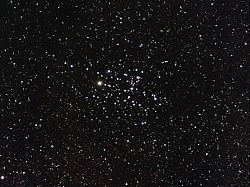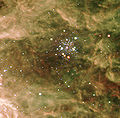Cluster
identifier | Image | Epoch J2000 | Constellation | Distance
(Light-years) | Age
(Myr) | Diameter | Apparent
magnitude | Notes |
|---|
| R. A. | Dec. |
|---|
| Hyades |  | 04h 26.9m | +15° 52′ | Taurus | 153 | 625 | 330' | 0.5 | [3] |
| Coma Star Cluster |  | 12h 22.5m | +25° 51′ | Coma Berenices | 280 | 400–500 | 120' | 1.8 | [4] |
| Messier 45 (Pleiades) |  | 03h 47.4m | +24° 07′ | Taurus | 444 | 125 | 120' | 1.2 | [5] |
| IC 2602 (Southern Pleiades/Theta Carinae Cluster) |  | 10h 43.2m | −64° 24′ | Carina | 486 | 30 | 100' | 1.9 | [6] |
| Alpha Persei Cluster | 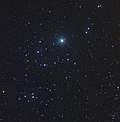 | 03h 26.0m | +49° 07′ | Perseus | 570 | 50 | 300' | 1.2 | [7] |
| IC 2391 (Omicron Velorum Cluster) |  | 08h 40.6m | −53° 02′ | Vela | 574 | 30 | 60' | 2.5 | [6] |
| NGC 2451 A |  | 07h 45.4m | −37° 58′ | Puppis | 600 | 50 | 45' | 2.8 | [8] [9] |
| Messier 44 (Beehive Cluster) |  | 08h 40.4m | +19° 41′ | Cancer | 610 | 830 | 70' | 3.1 | [10] [11] |
| Melotte 186 |  | 18h 01.1m | +02° 54′ | Ophiuchus | 652 | 100 | 240' | 3.0 | [12] |
| Blanco 1 | | 00h 04.3m | −29° 56′ | Sculptor | 850+160
−130 | 100 | 90' | 4.5 | [6] |
| Messier 7 (Ptolemy's Cluster) | 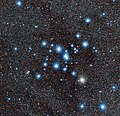 | 17h 53.8m | −34° 47′ | Scorpius | 980 ± 33 | 224 | 80' | 3.3 | [8] [13] |
| Messier 39 (Pyramid Cluster) |  | 21h 31.8m | +48° 27′ | Cygnus | 1,010 | 280 | 30' | 4.6 | [1] [8] |
| IC 348 | 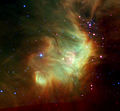 | 03h 44.6m | +32° 10′ | Perseus | 1,028 | 44 | 7' | 7.3 | [1] |
| NGC 6633 |  | 18h 27.7m | +06° 34′ | Ophiuchus | 1,040 | 660 | 20' | 4.6 | [14] |
| Pi Puppis Cluster |  | 07h 08m | −37° 10′ | Puppis | 1,040.5 | | 50' | 2.1 | [15] |
| NGC 2232 |  | 06h 26.4m | −04° 45′ | Monoceros | 1,060 | 53 | 45' | 3.9 | [1] [8] |
| Trumpler 10 |  | 08h 47.8m | −42° 29′ | Vela | 1,100 | 35 | 14' | 4.6 | [1] [8] |
| IC 4665 (Summer Beehive Cluster) | 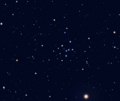 | 17h 46.3m | +05° 43′ | Ophiuchus | 1,120 | 43 | 70' | 4.2 | [1] |
| NGC 2547 |  | 08h 10.8m | −49° 18′ | Vela | 1,190 | 38 | 25' | 4.7 | [8] |
| Collinder 140 | | 07h 24.5m | −31° 51′ | Canis Major | 1,226 | 35 | 42' | 3.5 | [1] [8] |
| Sigma Orionis Cluster |  | 05h 38m | −02° 36′ | Orion | 1,263 | | | | |
| IC 4756 (Graff's Cluster) |  | 18h 39.0m | −05° 27′ | Serpens | 1,300 | 500 | 40' | 4.6 | [1] [8] |
| NGC 2516 (Southern Beehive Cluster) |  | 07h 58.0m | −60° 48′ | Carina | 1,300 | 141 | 30' | 3.8 | [8] [13] |
| Lambda Orionis Cluster |  | 05h 35m | +09° 56′ | Orion | 1,300 | 5 | | 2.8 | [16] |
| NGC 3532 (Wishing Well Cluster) | 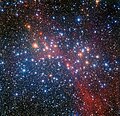 | 11h 06.4m | −58° 40′ | Carina | 1,321 | 316 | 50' | 3.0 | [8] [13] |
| Trapezium Cluster |  | 5h 35.4m | −05° 27′ | Orion | 1,344 ± 20 | 0.3 | 0.783' | 4.0 | [17] |
| NGC 752 |  | 01h 57.7m | +37° 47′ | Andromeda | 1,470 | 1,700–2,000 | 75' | 5.7 | [18] |
| Messier 34 (Spiral Cluster) |  | 02h 42.1m | +42° 46′ | Perseus | 1,500 | 180 | 36' | 5.2 | [1] [13] |
| Messier 6 (Butterfly Cluster) |  | 17h 40.1m | −32° 13′ | Scorpius | 1,590 | 94 | 20' | 4.2 | [1] |
| Messier 47 |  | 07h 36.6m | −14° 30′ | Puppis | 1,600 | 73 | 25' | 4.4 | [1] |
| NGC 6281 (Moth Wing Cluster) |  | 17h 04.7m | −37° 59′ | Scorpius | 1,611 | 220 | 8' | 5.4 | [1] |
| NGC 1980 (The Lost Jewel of Orion) |  | 5h 25.43m | −05° 54′ | Orion | 1,793 | 4.7 | 14' | 2.5 | [19] |
| Messier 25 |  | 18h 31.7m | −19° 07′ | Sagittarius | 2,000 | 92 | 30' | 4.6 | [1] |
| Messier 23 |  | 17h 57.0m | −18° 59′ | Sagittarius | 2,050 | 300 | 30' | 5.5 | [1] [13] |
| NGC 5662 |  | 14h 35.6m | −56° 37′ | Centaurus | 2,170 | 70 | 30' | 5.5 | [1] [13] |
| NGC 225 |  | 00h 43.6m | +61° 46′ | Cassiopeia | 2,200 | 130 | 12' | 7.0 | [1] |
| NGC 5460 |  | 14h 07.4m | −48° 20′ | Centaurus | 2,350 | 160 | 36' | 5.6 | [1] [13] |
| NGC 2264 |  | 06h 41.0m | +09° 53′ | Monoceros | 2,350 ± 52 | 1.5 | 40' | 3.9 | [20] |
| Messier 41 | 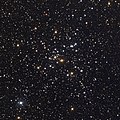 | 06h 46.0m | −20° 46′ | Canis Major | 2,360 | 240 | 40' | 4.5 | [1] [13] |
| NGC 6025 | 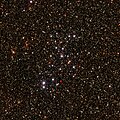 | 16h 03.3m | −60° 26′ | Triangulum Australe | 2,410 | 130 | 14' | 5.1 | [1] [13] |
| Messier 48 |  | 08h 13.7m | −05° 45′ | Hydra | 2,500 | 400 | 30' | 5.8 | [1] |
| IC 5146 |  | 21h 53.5m | +47° 16′ | Cygnus | 2,500±100 | 1 | 9' | 7.2 | [1] |
| Messier 67 (King Cobra Cluster/Golden Eye Cluster) |  | 08h 51.3m | +11° 48′ | Cancer | 2,610 – 2,930 | 4,000 | 25' | 6.9 | [1] [13] |
| NGC 2301 |  | 06h 51.75m | +00° 28′ | Monoceros | 2,840 | 165 | 12' | 6.0 | [21] |
| Messier 50 (Heart-shaped Cluster) |  | 07h 02.6m | −08° 23′ | Monoceros | 2,870 | 130 | 14' | 5.9 | [22] |
| IC 4651 |  | 17h 24.8m | −49° 56′ | Ara | 2,900 | 1,900 | 10' | 6.9 | [1] [13] |
| NGC 7822 (Berkeley 59) |  | 00h 04.0m | +68° 35′ | Cepheus | 2,900 | 2 | 180' | | [23] |
| Messier 35 (Shoe-Buckle Cluster) |  | 06h 09.1m | +24° 21′ | Gemini | 2,970 | 180 | 25' | 5.0 | [22] |
| NGC 3114 |  | 10h 02.7m | −60° 07′ | Carina | 2,970 | 124 | 36' | 4.2 | [1] |
| NGC 381 |  | 01h 08.3m | +61° 35′ | Cassiopeia | 3,120 ± 300 | 320 | 7' | 9.3 | [1] |
| Messier 93 (Critter Cluster) |  | 07h 44.6m | −23° 52′ | Puppis | 3,380 | 390 | 10' | 6.2 | [1] |
| NGC 1502 (Golden Harp Cluster) |  | 04h 07.8m | +62° 20′ | Camelopardalis | 3,452 | 10 | 8' | 5.7 | [1] |
| Messier 38 (Starfish Cluster) |  | 05h 28.7m | +35° 51′ | Auriga | 3,480 | 316 | 20' | 6.4 | [1] |
| NGC 6087 (S Normae Cluster) |  | 16h 18.8m | −57° 56′ | Norma | 3,500 | 70 | 14' | 5.4 | [1] [13] |
| NGC 6204 |  | 16h 46.1m | −47° 01′ | Ara | 3,540 | 79 | 6' | 8.2 | [1] |
| Collinder 121 | | 07h 08m | −37° 10′ | Canis Major | 3,590 ± 0.72 | | 50' | 2.6 | [24] |
| NGC 2169 |  | 06h 08.4m | +13° 58′ | Orion | 3,600 | 12 | 5' | 5.9 | [1] |
| NGC 2360 (Caroline's Cluster) |  | 07h 17.7m | −15° 38′ | Canis Major | 3,700 | 1,000 | 13' | 7.2 | [1] [13] |
| Messier 21 (Webb's Cross) |  | 18h 04.2m | −22° 29′ | Sagittarius | 3,930 | 12 | 14' | 5.9 | [1] |
| NGC 189 |  | 00h 39.7m | +61° 04′ | Cassiopeia | 4,200 | 10 | 3.7' | 8.8 | [1] |
| Messier 18 (Black Swan Cluster) |  | 18h 20.0m | −17° 06′ | Sagittarius | 4,230 | 17 | 5' | 6.9 | [1] |
| Messier 36 (Pinwheel Cluster) |  | 05h 36.2m | +34° 08′ | Auriga | 4,340 ± 0.87 | 25 | 10' | 6.0 | [1] |
| NGC 6242 |  | 16h 55.6m | −39° 28′ | Scorpius | 4,350 ± 0.53 | 50 | 9' | 6.4 | [1] [13] |
| Messier 37 (Salt and Pepper Cluster) |  | 05h 52.3m | +32° 33′ | Auriga | 4,500 | 347 | 14' | 5.6 | [1] |
| Messier 52 (Scorpion Cluster) | 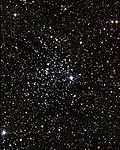 | 23h 24.8m | +61° 35′ | Cassiopeia | 4,600 | 160 | 15' | 6.9 | [1] |
| NGC 6067 |  | 16h 13.2m | −54° 13′ | Norma | 4,621 | 170 | 14' | 5.6 | [1] [13] |
| NGC 2362 (Tau Canis Majoris Cluster) |  | 07h 18.6m | −24° 59′ | Canis Major | 4,830 ± 0.97 | 4–5 | 5' | 4.1 | [25] |
| Messier 46 |  | 07h 41.7m | −14° 49′ | Puppis | 4,920 ± 980 | 250 | 20' | 6.1 | [1] |
| Messier 26 |  | 18h 45.3m | −09° 23′ | Scutum | 5,160 | 85 | 7' | 8.0 | [1] |
| NGC 2244 (Satellite Cluster) |  | 06h 31.9m | +04° 56′ | Monoceros | 5,200 | 1.9 | 30' | 4.8 | [1] |
| NGC 2355 |  | 07h 17.0m | +13° 47′ | Gemini | 5,380 | 955 | 5' | 9.7 | [1] [13] |
| NGC 188 (Polarissima Cluster) |  | 00h 48.4m | +85° 15′ | Cepheus | 5,400 | 6,600 | 17' | 8.1 | [13] [26] |
| NGC 129 |  | 00h 30.0m | +60° 13′ | Cassiopeia | 5,450 | 76 | 21′ | 6.5 | [27] |
| NGC 3766 (Pearl Cluster) |  | 11h 36.2m | −61° 37′ | Centaurus | 5,500 | 14 | 12' | 5.3 | |
| NGC 6231 (Baby Scorpion Cluster) |  | 16h 54.1m | −41° 50′ | Scorpius | 5,600 ± 400 | 6 | 14' | 2.6 | [1] [13] |
| Messier 16 (Eagle Nebula) |  | 18h 18.8m | −13° 49′ | Serpens | 5,700 ± 400 | 1.3 | 6' | 6.0 | [1] |
| Messier 11 (Wild Duck Cluster) | 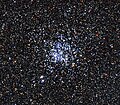 | 18h 51.1m | −06° 16′ | Scutum | 6,120 | 250 | 13' | 5.8 | [1] [13] [28] |
| NGC 2175 | 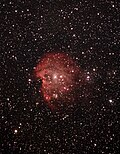 | 06h 09.7m | +20° 29′ | Orion | 6,350 | 8.9 | 5' | 6.8 | [1] |
| NGC 6756 |  | 19h 08.7m | +04° 42′ | Aquila | 6,363 | 62 | 4' | 4.5 | [1] |
| NGC 4755 (Jewel Box) |  | 12h 53.6m | −60° 22′ | Crux | 6,500 | 14 | 10' | 4.2 | [1] [13] |
| NGC 6200 |  | 16h 44.1m | −47° 28′ | Ara | 6,700 | 8.5 | 12' | 7.4 | [29] |
| NGC 6031 | 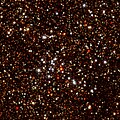 | 16h 07.9m | −54° 03′ | Norma | 6,800 ± 2.3 | 117 | 3' | 8.5 | [1] [30] |
| NGC 663 |  | 01h 46.1m | +61° 14′ | Cassiopeia | 6,850 | 25 | 14' | 7.1 | [1] |
| NGC 637 |  | 01h 43.0m | +64° 02′ | Cassiopeia | 7,045 ± 1.409 | 10 | 4.2' | 8.2 | [1] |
| NGC 2129 |  | 06h 01.1m | +23° 19′ | Gemini | 7,200 | 10 | 5' | 6.7 | [1] [31] |
| NGC 869 (h Persei) |  | 02h 19.1m | +57° 09′ | Perseus | 7,460 | 12 | 18' | 3.7 | [1] |
| NGC 1931 |  | 05h 31.0m | +34° 15′ | Auriga | 7,500 | 10 | 3' | 10.1 | [1] |
| NGC 884 (χ Persei) |  | 02h 22.0m | +57° 08′ | Perseus | 7,600 | 14 | 18' | 3.8 | [1] [13] |
| NGC 7789 (White Rose Cluster) |  | 23h 57.4m | +56° 43′ | Cassiopeia | 7,600 | 1,700 | 16' | 6.7 | [32] |
| NGC 457 (Dragonfly Cluster) |  | 01h 19.1m | +58° 17′ | Cassiopeia | 7,922 | 21 | 20' | 6.4 | [33] |
| Collinder 261 | | 12h 38.0m | −68° 22′ | Musca | 8,150 | 8,000 | 9' | 10.7 | [34] [35] |
| NGC 659 (Yin-Yang Cluster) |  | 01h 44.4m | +60° 40′ | Cassiopeia | 8,200 | 35 | 5' | 7.9 | [1] |
| NGC 3293 |  | 10h 35.8m | −58° 13′ | Carina | 8,400 | 8 | 8' | 4.7 | |
| NGC 7419 |  | 22h 54.3m | +60° 48.9′ | Cepheus | 9,130 | | 2' | 13 | |
| Messier 103 |  | 01h 33.4m | +60° 39′ | Cassiopeia | 9,400 | 16 | 5' | 7.4 | [36] |
| NGC 2509 |  | 08h 00.7m | −19° 04′ | Puppis | 9,500 | Uncertain [37] | 10' | 9.3 | [38] |
| Messier 24 (Small Sagittarius Star Cloud) |  | 18h 17.0m | −18° 29′ | Sagittarius | 10,000 | 220 | 90' | 2.5 | [1] [13] |
| NGC 6834 |  | 19h 52.2m | +29° 25′ | Cygnus | 10,850 | 76 | 5' | 7.8 | [1] [30] |
| NGC 2158 |  | 06h 07.4m | +24° 06′ | Gemini | 11,000 | 1,054 | 5' | 8.6 | [1] |
| NGC 2439 |  | 07h 40.8m | −31° 41′ | Puppis | 12,570 | 25 | 9' | 6.9 | [1] [13] |
| NGC 6791 | 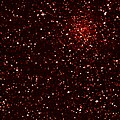 | 19h 20.9m | +37° 46′ | Lyra | 13,300 | 8,900 | 16' | 9.5 | [1] [13] |
| NGC 2204 |  | 06h 15.5m | −18° 40′ | Canis Major | 13,400 ± 1.3 | 787 | 13' | 8.6 | [1] |
| Gaia 1 |  | 06h 45.9m | −16° 45′ | Canis Major | 15,000 | 6,300 | 13' | 8.3 | |
| Ruprecht 7 | | 06h 57m 49.7s | −13° 13′ 38″ | Canis Major | 16,300-18,780 | | | | [39] [40] |
| Teutsch 2 | | 05h 41.4m | +39° 14′ | Auriga | 18,590 | 900 | 2' | 11 | [41] |
| Alicante 7 (RSGC5) | | 18h 44m 29.45s | −03° 30′ 02.4″ | Scutum | 19,600 | 16–20 | | | |
| Alicante 10 (RSGC6) | | 18h 45m 30s | −03° 40′ 00″ | Scutum | 19,600 | 16–20 | | | |
| Arches Cluster |  | 17h 45m 50.5s | −28° 49′ 28″ | Sagittarius | 25,000 | 2.5 | | | |
| Quintuplet Cluster | 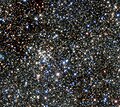 | 17h 46m 13.9s | −28° 49′ 48″ | Sagittarius | 26,000 | 4.8 | | | |
| Arp-Madore 2 | | 07h 38.8m | −33° 51′ | Puppis | 30,000 | 5,000 | 1.3' | | [42] |
|
